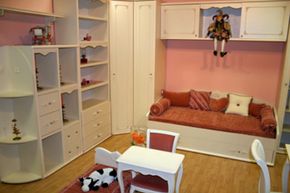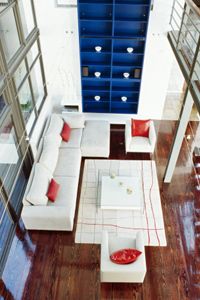 “Smart storage solutions can be your best friend in a tight space.iStockphoto/Thinkstock
“Smart storage solutions can be your best friend in a tight space.iStockphoto/Thinkstock
With the financial crisis of the last few years, a lot of people are looking at how they live and how they spend. Gone are the days of the McMansions and the stock-up shopping sprees at Target. Yes, we’re still a consumer culture, and that’s not all bad. But with multiple shows about hoarders on reality television, it’s evident that it would benefit us to learn to strike a healthier balance between ourselves and our possessions. There are blogs, newspaper articles and entire magazines focused on the relationships between people and their stuff, and they’re urging us to purge. Some are paring down for spiritual reasons; others because they’re simply out of space. And we all know there’s no greater challenge than to have to fit all of our Earthly possessions into a small space.
The key to maximizing a small space is to wisely utilize every square inch. Now, this is only possible if you have the right amount of stuff that will fit within those square inches. If you’re like most people, you probably have a surplus of stuff, so you’re going to need to get rid of everything but the necessities. For example, do you need a blender and a food processor? These items take up a lot of counter and cabinet space, and their functions are similar enough that unless you’re a smoothie master or an award-winning soup maker, you can probably pare down to the one you use the most. Even small specialty tools like apple corers and lemon zesters take up precious drawer space. Unless you’re using them on a weekly basis, you’re better off giving them away and freeing up some room. If you’re in a pinch, you can always borrow gadgets from someone with a bigger kitchen.
How to Maximize a Small Space
 “White on white on white will usually make a room feel smaller than it is.iStockphoto/Thinkstock
“White on white on white will usually make a room feel smaller than it is.iStockphoto/Thinkstock
Now that you’ve pared down to the essentials, take a look at your furniture. Do you have pieces that serve more than one function? Double-duty furniture is essential to small space living. An ottoman can serve as storage for blankets; a sofa might double as a sleeper for guests; and a dining room table could sport removable leaves that convert to a desk when you’re not eating. Add wall cabinets that hold your dishes as well as your office supplies, and you’re heading in the right direction. Closets also make great offices, and the space under the bed provides ample storage. You get the picture.
When decorating a small room, you want to be mindful of scale, but this doesn’t mean you need a room full of dollhouse furniture. While you don’t want to cram a bunch of oversized furniture into a small room, one good-sized statement piece, like a couch, may be exactly what the room needs to seem like it can hold its own. The key is to be sure there’s plenty of room to move around it. Also, how you position your furniture is just as important as what you put in a room. Sometimes putting a sofa at an angle rather than pushed up against a wall will make a small room appear larger — and it also leaves some space for much needed storage behind it. It’s all about the perception of space, so be sure to leave plenty between pieces.
How you decorate also has a big impact on how your space is perceived. While contrast is generally encouraged in a room to give it visual interest, less contrast will make a small room not seem quite so small. For this reason, white walls are best avoided. Try to choose a soft color that will blend better with furnishings and accessories. And speaking of accessories, the general rule of thumb for small spaces is to keep knick knacks to a minimum. That’s not to say that you can’t have some of your favorites on display, however. In order to not perceive a room as cluttered, the eye needs a place to rest. So groupings of your favorite tchotkes are a better option than scattering them throughout the room.
Organizing Tips for Small Spaces
 “Less clutter means more space.Stockbyte/Thinkstock
“Less clutter means more space.Stockbyte/Thinkstock
Getting organized is one thing. It’s staying organized that is perhaps one of the most daunting tasks for all of us. The key is to minimize the opportunities for clutter. A great place to start is to create a landing pad for the stuff you drop in your doorway when you come home. Hooks for your jacket and keys and a shelf for your bag will keep you from breaking your neck on your way out the door, or from having to shove everything off the dining room table onto the floor so you can eat dinner. You know all of those plastic grocery bags you’ve been saving just in case? Take all but a few of them to the nearest recycling bin. And yes, those bulk deals are tempting. But if you don’t have a place to store 24 rolls of paper towels, you’re probably better off sticking to the four-pack.
You’re limited to the floor space that you have, but going vertical can create tons more storage space, and shelving is a small space dweller’s best friend. Closets are a great place to start. There’s usually a lot of dead space up high and on the sides that can be maxed out with shelves for things like toiletries, seasonal gear, and extra linens. Have lots of books that aren’t display-worthy? Place some wrap around shelves high up on the wall for book storage. Unused corners are also great places for shelves to display nice books and knick knacks. No place for your CD collection? That’s fine, because CDs are out, anyway. Invest in a hard drive, convert all of them to mp3s, and sell the discs to a used CD store.
Repeat after me: A place for everything, and everything in its place. Make this your mantra as you get organized. Clutter can quickly overtake a small space, so it’s important that every single thing you own has a home, and that it gets put back in its home after use. A great way to ensure that you’ll always have a place for everything is to institute a "one in, one out" rule. This means every time you bring home something new, you need to find something to get rid of to make space for it. Not only is this a good exercise for your living space, your wallet will appreciate it, too. Trying to figure out how a new item fits into your life will help you consider if you’re buying something you really need.
Lots More Information
Related Articles
- 5 Tips for Designing Small Spaces
- How to Make the Most of a Studio Apartment
- Home Downsizing 101
Sources
- "10 Tips For Small Space Living." Apartmentherapy.com, 2010. http://www.apartmenttherapy.com/la/organizing/10-tips-for-small-space-living-080638
- "How to Make a Small Space Look Bigger." Thenest.com, 2010. http://ideas.thenest.com/decor-tricks/decor-style/slideshows/10-tips-for-making-a-small-space-bigger.aspx
- "Small Space Living: How to Maximize Your Space in a Small Apartment." Apartmenthomeliving.com, 2010. http://www.apartmenthomeliving.com/living/index.aspx?blog_id=412
- "Small-Space Makeover." Marthastewart.com, 2010. http://www.marthastewart.com/article/small-space-makeover







































